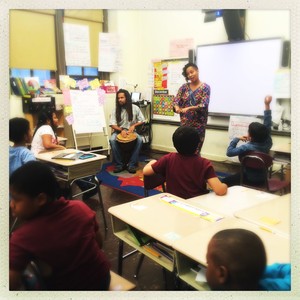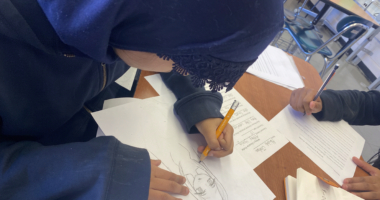Ever since I joined the Teaching Artist Training & Internship Program (TATIP), my Thursday afternoons have evolved into something I find special and out of the ordinary. Every Thursday I make my journey down to Brooklyn for my teaching residency at PS 676 The Red Hook Neighborhood School where I observe students and assist the Teaching Artists in executing the lesson plans.
Red Hook is not like any other part of Brooklyn I’ve explored. It’s one square mile in size and accessible only by car or bus after my stop on the subway. There are no maddening crowds or bustling bistros. Some parts are very isolated with somber looking warehouses surrounded by barbed wire. The B61 and B56, unpredictable as phantoms, grace the bus stops by chance before continuing on their circuitous routes. It’s as if the neighborhood is immune to gentrification or at least resilient to its effects. In the early 2000s there was a faux Starbucks sign on the corner of Van Brunt and Coffey Street, a gem I am determined to find.
Like many buildings in NYC, the school is old and covered in scaffolding. On the second floor is Mr. Collins’ fifth grade class where I have been completeing my residency. The fifth grade students at PS 676 are intelligent and rowdy. There are nineteen boys in the classroom, each one determined to impress and defy the adults in the room. They are not always receptive to music, poetry, or art. As with all great Teaching Artists, the TAs have found a way to blend these art forms to create a compelling and lasting unit. One element of the unit is centered on creating a character, a superhero in particular. The TAs ask the students to brainstorm what it means to be a superhero in one’s community. I was struck by this superhero unit from the get go. It is both a fun and creative way for the students to bridge their gusto with their imaginations.

In an easier more predictable world, we as Teaching Artists would teach children Art and only Art. But the reality is, we teach children. During my training I thought classroom management was the most dreadful reality of teaching. In many ways it is. What I didn’t know before my residency, however, was that classroom management can and must be demonstrated through vigor and grace. It is not a punishment for the students or the teachers. It’s an opportunity for growth and reflection, a spontaneous lesson within a lesson.
One week when the class became too disruptive, the Dance TA stopped her lesson to give the students a talk. During this talk she explained that she couldn’t continue teaching because disrespect casts a shadow onto her artistry. She told them she understood not everyone is a dancer but that class misbehavior is unacceptable. The most beautiful aspect of this talk was that the disciplining was rooted in elevating the students. She told them how proud she is of their progress, that their potential and aptitudes are inspiring. She told them she hopes they understand how gifted they are even if they never dance again.
“Everyone on earth moves,” she said, “You’ve got to find what works for you.”
-Emily Collins, TATIP Trainee, Writer




